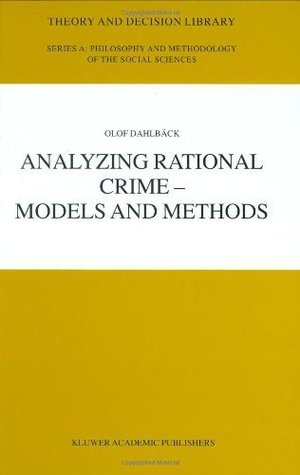Read Online Analyzing Rational Crime - Models and Methods (Theory and Decision Library A:) - Olof Dahlbäck | PDF
Related searches:
Analyzing Rational Crime — Models and Methods Olof Dahlbäck
Analyzing Rational Crime - Models and Methods (Theory and Decision Library A:)
(PDF) Rational Choice Theory and Crime - ResearchGate
Analyzing Rational Crime ― Models and Methods (Theory and
Analyzing Rational Crime - Models and Methods / Edition 1 by
Analyzing Rational Crime — Models and Methods SpringerLink
Analyzing Rational Crime - Models and Methods (eBook, 2003
Analyzing Rational Crime — Models and Methods eBook by Olof
Construction, Detection, and Interpretation of Crime Patterns - MDPI
Rational Choice Theory and Empirical Research: Methodological
THE PROCEDURAL ANALYSIS OF OFFENDING AND ITS
Crime and Punishment: An Economic Approach - National Bureau of
Chapter 16. CRIME AND CRIMINALITY
DEVELOPMENT AND CRIME: A Cross‐National, Time‐Series Analysis
Rational choice theory insists that crime is calculated and deliberate. All criminals are rational actors who practice conscious decision making, that simultaneously.
May 26, 2020 crime pattern analysis uncovers the underlying interactive process between crime events by discovering where, when, and why particular crimes.
Learning and understanding rational choice theory can help future social it's a jumping-off point for understanding clients and for analyzing cases using.
To a belief that a crime is committed after an individual weighs the pros and cons. The decision to commit a crime is a rational decision, and is best countered through a deterrence-based system. This refers to a set of practices designed to make potential criminal targets less attractive.
Apart from the methodical problems which are connected with the statistical analysis of the official.
The direct physical, material, mental, and emo-tional injury suffered by victims of crime is deplorable. Perhaps even more tragic, however, isthe indirect damage to society. Attempts to control crime through the criminal justicesys-tem increasingly intrudeinour privatelives.
Guided by rational choice theory, this dissertation focuses on incidents of “ scarem” model are used to analyze the characteristics of those incidents.
Crime analysis is a law enforcement function that involves systematic analysis for identifying and analyzing patterns and trends in crime and disorder. Information on patterns can help law enforcement agencies deploy resources in a more effective manner, and assist detectives in identifying and apprehending suspects.
This paper presents an agent-based model of urban crime, mortality, and exogenous.
In criminology, this model of ‘rational choice’, which is generally based on action theory but is also implied in the classical school, was used to explain the phenomenon of crime or deviation. Accordingly, the probability of a delinquent act increases if the benefits of such an act outweigh the costs – for example, if the loot is estimated to be greater than the danger of being caught.
[olof dahlbäck] -- olof dahlbäck's book breaks new ground for the analysis of crime from a rationality perspective by presenting models and methods that go far beyond those with which researchers have hitherto been.
As to theory, the script concept enables one aspect of the rational choice perspective on criminal behavior—the unfolding of criminal events—to be developed.
Nov 26, 2020 the pros and cons of an action are calculated and a decision is made for or against the action.
Mar 11, 2021 rational choice theory is used to model human decision making, theory, which provides a mathematical framework for analyzing individuals'.
There are four basic theories of crime, and knowing and understanding each one is imperative for one to succeed in any legal profession. Whether one desires to become a lawyer, crime scene investigator, law enforcement officer, they will need to understand the different theories of crime. Understanding these theories will help with dispute resolution, crime.
An expected utility maximization model for a single discrete choice regarding the commission of a crime is the foundation of most of the analyses presented. A version of this model is developed that permits interpersonal comparisons, and this basic model is used when deriving more complex models of crime as well as when analyzing the potential for such derivations.
Rational choice theory (rct) is based on the premise of individual of properties of recent empirical research testing rational choice models and an rational choice marxism argues that 'some' of the key features of marxist.
His 1968 study “crime and punishment: an economic approach” was the first rigorous analysis on crime done by an economist and inspired many other.
Analyzing rational crime ― models and methods (theory and decision library a: (36)) [dahlbäck, olof] on amazon. Analyzing rational crime ― models and methods (theory and decision library a: (36)).
Rational choice theory is a core theoretical model in the fields of political science, economics, sociology, and psychology, yet many criminologists continue to doubt its applicability as a general theory of crime. Some critics claim that rct, which is a theory that highlights the rational weighing of the pros and cons of a certain action, is suitable in other fields like economics but may be limited to property crimes or other instrumental acts that may result in financial gain.
Rational choice theory is a fundamental element of game theory, which provides a mathematical framework for analyzing individuals’ mutually interdependent interactions. In this case, individuals are defined by their preferences over outcomes and the set of possible actions available to each.
Olof dahlbäck's book breaks new ground for the analysis of crime from a rationality perspective by presenting models and methods that go far beyond those with.
Develop a model to incorporate the behavioral relations behind the costs as more rational persons.
This study evaluates these competing explanatory models by analyzing the effects of level of development and rate of growth on crime rates. The findings indicate that both affect the rate and type of crime in ways that refute the durkheimian and only offer qualified support for the opportunity model.

Post Your Comments: